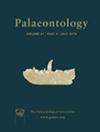Did the Late Ordovician mass extinction event trigger the earliest evolution of ‘strophodontoid’ brachiopods?
IF 2.3
2区 地球科学
Q1 PALEONTOLOGY
引用次数: 1
Abstract
‘Strophodontoid’ brachiopods represented the majority of strophomenide brachiopods in the Silurian and Devonian periods. They are characterized by denticles developed along the hinge line. The evolution of denticles correlated with the disappearance of dental plates and teeth and were already present when the clade originated in the Late Ordovician. Specimens of Eostropheodonta parvicostellata from the Kuanyinchiao Bed (early–middle Hirnantian, uppermost Ordovician) in the Hetaoba Section, Meitan, Guizhou Province, South China, display clear fossil population variation, during a process of loss of dental plates and the development of denticles. Three phenotypes of E. parvicostellata are recognized in a single fossil bed, likely heralding a speciation process. Non‐metric multidimensional scaling (NMDS) based on five key characters of genera of the Family Leptostrophiidae shows a much wider morphospace for Silurian genera than for those in the Devonian. Phylogenetic analysis of the Family Leptostrophiidae supports the NMDS analysis and mostly tracks their geological history. The fossil population differentiation in E. parvicostellata discovered between the two phases of the Late Ordovician mass extinction event (LOME) linked to a major glaciation, suggests a Hirnantian origination of the ‘strophodontoid’ morphology, and links microevolutionary change to a macroevolutionary event.晚奥陶世大灭绝事件是否引发了腕足类动物的最早进化?
志留纪和泥盆纪以“Strophodontoid”腕足类动物为主。它们的特征是沿铰链线发育的小齿。齿尖的进化与牙板和牙齿的消失有关,在进化支起源于晚奥陶纪时就已经存在了。贵州梅潭河套坝剖面观音桥层(上奥陶统海南田早-中)的小齿东齿(Eostropheodonta parvicostellata)化石在牙板丢失和牙齿发育过程中表现出明显的种群变异。在一个化石层中发现了三种不同的表型,可能预示着一个物种形成过程。基于5个关键特征的非度量多维标度(NMDS)显示,志留系的属比泥盆系的属具有更宽的形态空间。钩端蝇科的系统发育分析支持NMDS分析,并主要追踪其地质历史。在与大冰期有关的晚奥陶世大灭绝事件(LOME)的两个阶段之间发现的化石种群分化表明,“齿状突”形态起源于Hirnantian,并将微观进化变化与宏观进化事件联系起来。
本文章由计算机程序翻译,如有差异,请以英文原文为准。
求助全文
约1分钟内获得全文
求助全文
来源期刊

Palaeontology
地学-古生物学
CiteScore
5.60
自引率
3.80%
发文量
43
审稿时长
6 months
期刊介绍:
Palaeontology publishes a wide variety of papers on palaeontological topics covering:
palaeozoology
palaeobotany
systematic studies
palaeoecology
micropalaeontology
palaeobiogeography
functional morphology
stratigraphy
taxonomy
taphonomy
palaeoenvironmental reconstruction
palaeoclimate analysis and biomineralization studies.
 求助内容:
求助内容: 应助结果提醒方式:
应助结果提醒方式:


